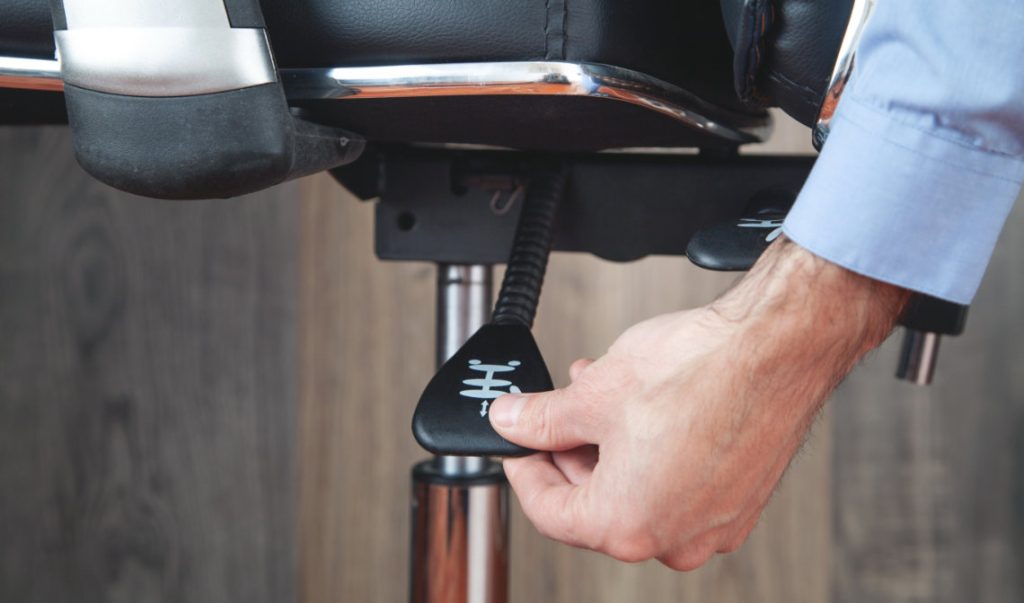Most professionals spend a significant amount of time every day sitting in their office chairs. In the long run, the wrong sitting posture and a poorly adjusted office chair can lead to a wide range of musculoskeletal disorders and even chronic pain. That’s why it’s so important to learn how to adjust your office chair to ensure maximum comfort, proper posture, and optimal productivity throughout the day.
Ergonomic office chairs are by nature geared to make you comfortable for long sittings. In this blog post, you are going to learn how to adjust your task chair by looking at some key factors that include seat height adjustments, seat depth, lumbar support, armrests, and tilt mechanisms. By the end of this article, you’ll have a better understanding of how to set up your chair for maximum comfort, productivity, and overall well being.
5 Steps to maximize comfort

Step 1
Adjusting Chair Height: Start by setting the height of your office chair so that your feet are flat on the floor, with your knees at a 90-degree angle. If you’re working at an adjustable-height desk, this will likely involve setting your chair high enough to match the desk surface. Conversely, if you’re working at a standard desk, you may need to adjust the height of your chair slightly to keep your feet flat on the floor. If you feel that you tend to lean forward, it means that your desk height is too high.
Step 2
Optimizing Seat Depth: Being able to adjust the seat depth is a key feature of an ergonomic office chair and have good posture. This feature ensures that people of different sizes are able to sit comfortably. Adjust the seat depth of your task chair, so that your lower back is supported by the backrest, and there’s a slight gap between the back of your knees and the end of the seat by about 2.5″. Proper seat depth ensures that you do not put pressure on the back of your legs which will affect the blood circulation. It also ensures that you get full support on your lumbar region. Never seat forward or at the edge of your seat.
Step 3
Lumbar Support: A fully adjustable chair has a built-in adjustable lumbar support. This additional support helps to keep the natural curve of your lower spine, which minimizes lower-back strain. Adjust the lumbar support to match the natural curve of your lower back and ensure it’s positioned snugly against your back.
Step 4
Armrest Positioning: Adjust the height of the armrests is essential for minimizing shoulder and neck ache. The ideal position for armrests is elbow height which ensures that your arms rest comfortably on them, without raising or lowering your shoulders. Individuals have different body proportions and comfort preferences. In essence, optimizing armrest position to the proper height on an office chair is a fundamental aspect of ergonomic design. It not only enhances immediate comfort but also plays a crucial role in preventing long-term musculoskeletal issues associated with poor sitting habits.
Step 5
Tilt mechanism: Finally, it’s important to consider the tilt mechanism of your office chair. If you like to lock your office chair in a certain position, make sure it is not completely upright. Locking your office chair at a slight angle, as opposed to keeping it upright, offers ergonomic advantages. This promotes spinal alignment, distributes body weight evenly, engages core muscles, provides relief to the lower back, and reduces overall fatigue. The subtle tilt strikes a balance between comfort and support, enhancing both immediate well-being and long-term health during extended periods of sitting. If you prefer to always keep your chair unlocked, make sure the tension/resistance is adequate so it is not too easy or too hard to do so.
It’s ok to keep adjusting – Listen to your body
With the increased demands working professionals now experience, sitting properly by having good posture is essential to take good care of your physical wellness. A properly adjusted office chair is crucial for minimizing physical stress and discomfort, which in turn can improve your overall quality of life. By following our guidelines above and taking into account your body’s unique needs, you can set up your office chair for maximum comfort, support, and productivity throughout the day.

